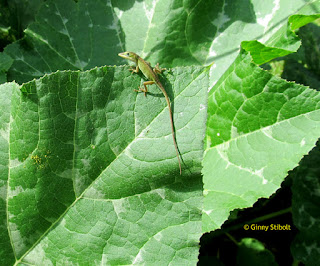 |
| I'd been using these elevated barrels since Feb. 2009. |
These 3 elevated rain barrels have been well used over the years, because their placement near the edible gardens means that I have been able to use a hose to water thirsty crops rather than hauling watering cans. My back has been grateful.
Our best growing season here in north Florida is Fall, Winter, and early Spring--these are our dry months, but rarely have the barrels run dry during those times. I also have 3 other rain barrels not too far away, but they have not been set up with a single drain like these. See my post Three More Barrels for details on how my husband installed them.
After 8 years, it was time to rework the barrels...
 |
| Neat tubes of algae lined most of the pipes. |
The wood platform should have had better bracing, because a few years after installation that the wood began to sag under the weight when the three 55-gallon barrels were full. Still, the sag was okay, but recently the wood had begun to rot and carpenter bees had drilled into it even though it was pressure treated lumber. It was time to replace the platform.
We took advantage of the slow beginning of the wet season in June and drained the barrels. Then my husband dismantled the piping and removed the barrels from the damaged platform. He thoroughly rinsed out the barrels and let them completely dry out.
Neat tubes of algae lined the pipes. They were added to the compost pile.
Cinder blocks replaced the wood
Lesson learned: avoid wood. Cinder blocks offer a number of advantages for this situation, so we made the switch. |  |
| Checking the levels. It's important that for this type of installation that all the barrels are at the same level. | Each barrel sat on its own tower of cinder blocks This time the plumbing is exposed. |
 |  |
| The drain pipes were hooked together and then to the spigot. | The barrels were not as elevated as before, so extensions up closer to the gutter drains were needed. |
 |  |
| A metal stake was attached to the spigot with a plastic tie to stabilize it. Then the hose was attached. We were ready to go... | A few weeks later: Checking the levels after the barrels were filled. |
The finished set-up
One other item, is the overflow pipes. When the barrels fill up the excess water is directed through a pipe attached to the tops of the barrels. This pipe is attached to a hose that carries this excess water out behind the shed to a swale where it can be absorbed into the soil.
 |  |
| At ground level the overflow pipe attaches to a hose--to the left of this photo. | Top view of the overflow pipes. |
Seminole pumpkins!
Note the Seminole pumpkins to the right of the rain barrels in the above photo. They are still going strong in August. What a bountiful crop we've enjoyed. |  |
| A Seminole pumpkin watcher...There is a a lot to watch for because the pollinators are thick around the pumpkin flowers. | These Seminole pumpkin burgers were delish! |
Recipe for Seminole pumpkin burgers
| For 6 burgers: 2 cups of grated Seminole pumpkin--picked while still green and peeled before grating 1/3 cup grated Parmesan cheese 1/4 cup plain nonfat yogurt 1/3 cup flour 1/2 cup potato flakes (approximate) 1/2 cup pre-sauted diced onions with diced garlic (almost a cup before cooking) 3 medium eggs Fresh ground pepper to taste Enough olive oil to have about 1/8th of an inch in the pan | Mix all ingredients (except oil) in a bowl and adjust the consistency with the potato flakes so that the patty stays together. Heat oil to 350 degrees (we use an induction burner so have exact temps.) Cook for several minutes on each side, but move the patty around in the oil so it doesn't stick. Cook one side to brown as shown and flip to other side.Cook only 1 or 2 burgers as once to keep enough room to flip the burgers. |
 |
| The beautyberries are adding color to become their amazingly eye-popping purple of fall. |
Late summer!
You know it's officially late summer when the beautyberries start turning purple. They will become unbelievably purple and will feed the migratory birds that come through our yard this winter.
I hope you're enjoying your summer.
Green Gardening Matters,
Ginny Stibolt
No comments: